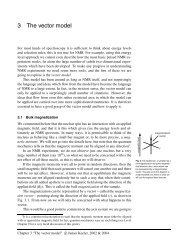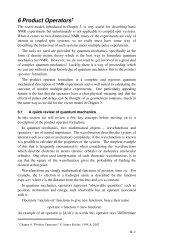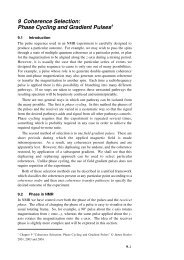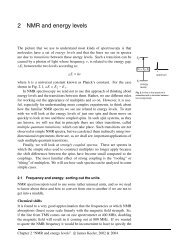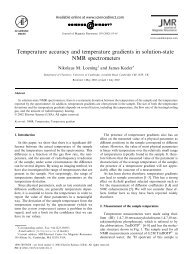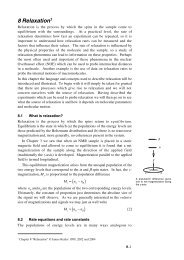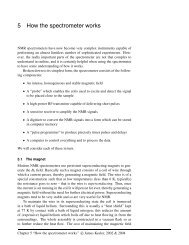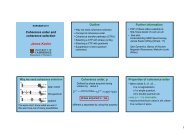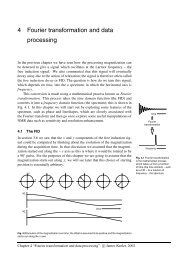Elimination of Zero-Quantum Interference in Two-Dimensional NMR ...
Elimination of Zero-Quantum Interference in Two-Dimensional NMR ...
Elimination of Zero-Quantum Interference in Two-Dimensional NMR ...
Create successful ePaper yourself
Turn your PDF publications into a flip-book with our unique Google optimized e-Paper software.
Angewandte<br />
Chemie<br />
<strong>Two</strong>-<strong>Dimensional</strong> <strong>NMR</strong> Spectroscopy<br />
<strong>Elim<strong>in</strong>ation</strong> <strong>of</strong> <strong>Zero</strong>-<strong>Quantum</strong> <strong>Interference</strong> <strong>in</strong><br />
<strong>Two</strong>-<strong>Dimensional</strong> <strong>NMR</strong> Spectra**<br />
Michael J. Thrippleton and James Keeler*<br />
High-resolution <strong>NMR</strong> experiments <strong>of</strong>ten conta<strong>in</strong> periods<br />
dur<strong>in</strong>g which the magnetization is placed along the z-axis. For<br />
example, the magnetization must be along the z-axis dur<strong>in</strong>g<br />
the mix<strong>in</strong>g time <strong>in</strong> a NOESY experiment so that crossrelaxation<br />
can take place. Either phase cycl<strong>in</strong>g or field<br />
gradient pulses are used to ensure that only the wanted z-<br />
magnetization ends up contribut<strong>in</strong>g to the spectrum. However,<br />
neither <strong>of</strong> these methods can dist<strong>in</strong>guish between z-<br />
magnetization and homonuclear zero-quantum coherence,<br />
which is <strong>in</strong>variably present. The zero-quantum coherence<br />
gives rise to anti-phase dispersive components <strong>in</strong> the spectra,<br />
thereby reduc<strong>in</strong>g the effective resolution, <strong>in</strong>troduc<strong>in</strong>g mislead<strong>in</strong>g<br />
correlations, and obscur<strong>in</strong>g wanted features. Over the<br />
years a number <strong>of</strong> methods have been devised to suppress<br />
these zero-quantum contributions, [1–5] but it is fair to say that<br />
none <strong>of</strong> these methods have proved entirely satisfactory.<br />
Here<strong>in</strong> we present a new method for suppress<strong>in</strong>g zeroquantum<br />
coherence; the method is widely applicable, does<br />
not extend the duration <strong>of</strong> the experiment significantly, and<br />
can be implemented easily on any modern spectrometer.<br />
Our new method <strong>of</strong> zero-quantum suppression <strong>in</strong>volves<br />
apply<strong>in</strong>g simultaneously a swept-frequency 1808 pulse and a<br />
gradient. Figure 1a shows how this comb<strong>in</strong>ation can be<br />
<strong>in</strong>troduced <strong>in</strong>to the NOESY pulse sequence. The way <strong>in</strong><br />
which this swept-pulse/gradient pair works can be envisaged<br />
<strong>in</strong> the follow<strong>in</strong>g way. The application <strong>of</strong> the gradient (along<br />
the z-axis) results <strong>in</strong> the Larmor frequency becom<strong>in</strong>g a<br />
function <strong>of</strong> position <strong>in</strong> the <strong>NMR</strong> tube. The swept-frequency<br />
1808 pulse will therefore flip the sp<strong>in</strong>s at different positions <strong>in</strong><br />
the sample at different times. Thus, the top <strong>of</strong> the sample<br />
might experience the 1808 pulse at the start <strong>of</strong> the sweep, the<br />
middle <strong>of</strong> the sample at time t f /2, and the bottom at time t f ,<br />
where t f is the duration <strong>of</strong> the sweep. In general, the<br />
1808 pulse occurs at time at f , where a is 0 at the top <strong>of</strong> the<br />
sample and 1 at the bottom.<br />
The 1808 pulse forms a sp<strong>in</strong> echo which refocuses the<br />
evolution <strong>of</strong> the zero-quantum coherence over a time 2at f ;<br />
however, for the rema<strong>in</strong>der <strong>of</strong> the time, (1–2a)t f , the zeroquantum<br />
cont<strong>in</strong>ues to evolve. The result is that <strong>in</strong> different<br />
Figure 1. Pulse sequence tim<strong>in</strong>g diagrams for the a) NOESY, b) z-<br />
COSY, and c) TOCSY experiments <strong>in</strong>corporat<strong>in</strong>g swept-pulse/gradient<br />
pairs for the dephas<strong>in</strong>g <strong>of</strong> zero-quantum coherence. Radi<strong>of</strong>requency<br />
pulses are shown on the l<strong>in</strong>e marked RF. Unless otherwise specified,<br />
filled-<strong>in</strong> rectangles represent pulses <strong>of</strong> flip angle 908 and phase x, and<br />
swept-frequency 1808 pulses are <strong>in</strong>dicated by an open box conta<strong>in</strong><strong>in</strong>g a<br />
diagonal l<strong>in</strong>e. Gradient pulses are shown on the l<strong>in</strong>e marked G. G HS<br />
denotes a homospoil gradient pulse. The z-filter pulse sequence element<br />
shown <strong>in</strong> (d) results <strong>in</strong> the selection <strong>of</strong> <strong>in</strong>-phase magnetization<br />
along the y-axis. <strong>Zero</strong>-quantum suppression can be <strong>in</strong>troduced <strong>in</strong>to<br />
this element as shown <strong>in</strong> (e); this modified z-filter appears <strong>in</strong> sequences<br />
(a)–(c). We note that the swept-frequency pulse may be considered<br />
as part <strong>of</strong> the mix<strong>in</strong>g time <strong>in</strong> the NOESY pulse sequence (a).<br />
parts <strong>of</strong> the sample the zero-quantum has evolved for<br />
different times, and so has acquired a different phase. If the<br />
range <strong>of</strong> these phases across the sample is large enough, the<br />
net result will be cancelation <strong>of</strong> the zero-quantum coherence.<br />
A simple calculation (see Support<strong>in</strong>g Information) shows<br />
that the degree <strong>of</strong> attenuation A <strong>of</strong> the zero-quantum<br />
depends on both its frequency, W ZQ (<strong>in</strong> rad s 1 ), and the<br />
length <strong>of</strong> the swept-pulse/gradient pair, t f , [Eq. (1)]:<br />
[*] Dr. J. Keeler, M. J. Thrippleton<br />
Department <strong>of</strong> Chemistry<br />
University <strong>of</strong> Cambridge<br />
Lensfield Road, Cambridge, CB2 1EW (UK)<br />
Fax: (+ 44)1223-336-362<br />
E-mail: jhk10@cam.ac.uk<br />
[**] This work was supported by the EPSRC, Procter & Gamble, and the<br />
Newton Trust. We are grateful to Dr. David Neuhaus for a generous<br />
allocation <strong>of</strong> spectrometer time at the MRC LMB.<br />
Support<strong>in</strong>g <strong>in</strong>formation for this article is available on the WWW<br />
under http://www.angewandte.org or from the author.<br />
A ¼ s<strong>in</strong> W ZQ t f<br />
W ZQ t f<br />
W ZQ is simply (W 1 W 2 ), where W 1 and W 2 are the<br />
frequencies <strong>of</strong> the two sp<strong>in</strong>s <strong>in</strong>volved. If the oscillations<br />
produced by the s<strong>in</strong>e term are ignored, the zero-quantum is<br />
attenuated by a factor 1/W ZQ t f . For example, for a zeroquantum<br />
frequency <strong>of</strong> 500 Hz (namely, with two sp<strong>in</strong>s<br />
separated by 1 ppm at 500 MHz) and a t f value <strong>of</strong> 30 ms, the<br />
attenuation factor will be 0.01, that is, the zero-quantum<br />
coherence is reduced to 1% <strong>of</strong> its orig<strong>in</strong>al size.<br />
ð1Þ<br />
Angew. Chem. Int. Ed. 0000, 00, 0–0 DOI: 10.1002/anie.200351947 2003 Wiley-VCH Verlag GmbH & Co. KGaA, We<strong>in</strong>heim<br />
1
Communications<br />
The key feature <strong>of</strong> our new method is that suppression <strong>of</strong><br />
zero-quantum coherence is achieved <strong>in</strong> a s<strong>in</strong>gle scan; no<br />
repetition <strong>of</strong> the experiment is necessary. This represents a<br />
very significant improvement over the usual method <strong>of</strong> zeroquantum<br />
suppression, which is to repeat the experiment for a<br />
range <strong>of</strong> mix<strong>in</strong>g times <strong>of</strong> the order <strong>of</strong> 2p/W ZQ . [1] Not only does<br />
this greatly extend the m<strong>in</strong>imum required experiment time,<br />
but it is also difficult to choose a small set <strong>of</strong> mix<strong>in</strong>g-time<br />
values which give adequate suppression over a range <strong>of</strong> zeroquantum<br />
frequencies. The alternative approach <strong>of</strong> vary<strong>in</strong>g the<br />
mix<strong>in</strong>g time randomly from one t 1 <strong>in</strong>crement to the next<br />
merely transforms the unwanted signals <strong>in</strong>to t 1 noise. [1]<br />
In a previous study we showed how sp<strong>in</strong>-lock<strong>in</strong>g <strong>in</strong> the<br />
presence <strong>of</strong> an <strong>in</strong>homogeneous B 0 or B 1 field can also result <strong>in</strong><br />
the dephas<strong>in</strong>g <strong>of</strong> zero-quantum coherence. [4] However, the<br />
technique proposed here<strong>in</strong> is far superior to our earlier work<br />
<strong>in</strong> that the new approach is simpler to implement, leads to<br />
faster dephas<strong>in</strong>g <strong>of</strong> the zero-quantum coherence, and does not<br />
suffer from additional complications, such as unwanted<br />
TOCSY-type transfer.<br />
Figure 2 compares part <strong>of</strong> the NOESY spectrum <strong>of</strong><br />
strychn<strong>in</strong>e recorded with and without the new zero-quantum<br />
suppression method; a short mix<strong>in</strong>g time t m <strong>of</strong> 400 ms has<br />
been used, as it is under these conditions that the anti-phase<br />
contributions are most troublesome. Figure 2a shows a<br />
spectrum recorded without zero-quantum suppression; the<br />
significant phase distortions on both the diagonal- and crosspeak<br />
multiplets arise from the zero-quantum coherence<br />
present dur<strong>in</strong>g the mix<strong>in</strong>g time. Figure 2a’ shows a spectrum<br />
recorded us<strong>in</strong>g the new zero-quantum suppression method:<br />
the anti-phase dispersive contributions are removed, which<br />
leaves all <strong>of</strong> the peaks <strong>in</strong> pure absorption—the improvement<br />
is dramatic (the rema<strong>in</strong><strong>in</strong>g <strong>in</strong>tensity distortions result from a<br />
comb<strong>in</strong>ation <strong>of</strong> strong coupl<strong>in</strong>g and flip-angle effects).<br />
Clearly, one-dimensional NOE experiments, such as the<br />
double-pulsed field gradient sp<strong>in</strong> echo (DPFGSE) NOE,<br />
which also require zero-quantum suppression, will benefit<br />
from the same approach.<br />
There are other experiments <strong>in</strong> which the new zeroquantum<br />
suppression method can be used to good effect; here<br />
we consider just two: z-COSY and TOCSY. The z-COSY<br />
experiment is similar to NOESY except that the two pulses<br />
bracket<strong>in</strong>g the mix<strong>in</strong>g period have small flip angles, typically<br />
208. [6] In the result<strong>in</strong>g spectrum both the cross- and diagonalpeak<br />
multiplets have absorption-mode l<strong>in</strong>e shapes and, most<br />
importantly, the multiplets are “reduced”, thus mak<strong>in</strong>g it<br />
possible to measure both the size and relative sign <strong>of</strong> passive<br />
coupl<strong>in</strong>gs.<br />
Effective suppression <strong>of</strong> zero-quantum coherences that<br />
are present between the two small flip angle pulses is crucial<br />
to the success <strong>of</strong> the z-COSY experiment; the pulse sequence<br />
<strong>in</strong> Figure 1b shows how this can be achieved by us<strong>in</strong>g the new<br />
method. Figure 2b shows part <strong>of</strong> the z-COSY spectrum <strong>of</strong><br />
strychn<strong>in</strong>e recorded without zero-quantum suppression; significant<br />
dispersive contributions obscure the f<strong>in</strong>e structure <strong>of</strong><br />
the multiplets. <strong>Zero</strong>-quantum suppression gives the dramatic<br />
improvement shown <strong>in</strong> Figure 2b’: the l<strong>in</strong>e shapes are<br />
absorptive and the reduced multiplets can now clearly be<br />
seen.<br />
Figure 2. Comparison <strong>of</strong> spectra recorded without zero-quantum suppression<br />
(left) and with (right) the new swept-pulse/gradient method<br />
for the suppression <strong>of</strong> zero-quantum coherence; a, a’): NOESY spectra<br />
(mix<strong>in</strong>g time 400 ms), b, b’): z-COSY spectra, and c, c’): TOCSY spectra<br />
(mix<strong>in</strong>g time 23 ms). The same region <strong>of</strong> the spectrum <strong>of</strong> strychn<strong>in</strong>e is<br />
shown <strong>in</strong> each case. The spectra on the left all show dispersive antiphase<br />
contributions aris<strong>in</strong>g from zero-quantum coherence present<br />
dur<strong>in</strong>g the mix<strong>in</strong>g time. In the spectra shown on the right, these contributions<br />
have been removed by the new dephas<strong>in</strong>g method; as a result,<br />
the spectra show pure absorption l<strong>in</strong>e shapes and are thus much<br />
easier to <strong>in</strong>terpret. Positive contours are <strong>in</strong>dicated by full l<strong>in</strong>es, negative<br />
contours by dashed l<strong>in</strong>es; the F 1 -axis is vertical.<br />
F<strong>in</strong>ally, we consider TOCSY (total correlation spectroscopy)<br />
experiments. [7] Aga<strong>in</strong>, the pulse sequence is similar to<br />
that used <strong>in</strong> NOESY experiments except that an isotropic<br />
mix<strong>in</strong>g sequence (such as DIPSI-2) is applied dur<strong>in</strong>g the<br />
mix<strong>in</strong>g time. Such a sequence results <strong>in</strong> the <strong>in</strong>terchange <strong>of</strong> z-<br />
magnetization between coupled sp<strong>in</strong>s via a state <strong>of</strong> zeroquantum<br />
coherence. To obta<strong>in</strong> spectra with pure phase, it is<br />
necessary to dephase zero-quantum coherence present both<br />
before and after the period <strong>of</strong> isotropic mix<strong>in</strong>g; a suitable<br />
pulse sequence is shown <strong>in</strong> Figure 1c. Note that to avoid the<br />
zero-quantum coherence dephased by the first swept-pulse/<br />
gradient pair be<strong>in</strong>g rephased <strong>in</strong> the second, different durations<br />
(t f1 and t f2 ) must be used.<br />
2 2003 Wiley-VCH Verlag GmbH & Co. KGaA, We<strong>in</strong>heim www.angewandte.org Angew. Chem. Int. Ed. 0000, 00, 0–0
Angewandte<br />
Chemie<br />
Figure 2c shows part <strong>of</strong> the TOCSY spectrum <strong>of</strong> strychn<strong>in</strong>e<br />
recorded without any suppression <strong>of</strong> the zero-quantum<br />
contributions; the presence <strong>of</strong> anti-phase dispersive contributions<br />
is clear, both for cross- and diagonal-peak multiplets.<br />
In contrast, the spectrum shown <strong>in</strong> Figure 2c’, recorded us<strong>in</strong>g<br />
the new zero-quantum suppression method, has multiplets<br />
that are both <strong>in</strong>-phase and with absorption-mode l<strong>in</strong>e shapes.<br />
In fact, all <strong>of</strong> these experiments can be thought <strong>of</strong> as<br />
utiliz<strong>in</strong>g a z-filter, which is the pulse sequence element shown<br />
<strong>in</strong> Figure 1d; it is used to select one <strong>in</strong>-phase component <strong>of</strong><br />
transverse magnetization by rotat<strong>in</strong>g it, temporarily, on to the<br />
z-axis. Figure 1e shows how the z-filter element can be<br />
modified to <strong>in</strong>clude our new method for zero-quantum<br />
suppression.<br />
We are confident that the method presented here is also<br />
applicable to <strong>NMR</strong> spectroscopic analysis <strong>of</strong> biological<br />
macromolecules. Much shorter NOESY mix<strong>in</strong>g times are<br />
typically used for such molecules, and the duration <strong>of</strong> the<br />
swept-frequency pulse will limit the shortest mix<strong>in</strong>g-time<br />
available. The sweep will also need to be kept short <strong>in</strong> other z-<br />
filtered experiments to m<strong>in</strong>imize relaxation losses. However,<br />
while a somewhat generous t f value <strong>of</strong> 50 ms was ma<strong>in</strong>ly used<br />
<strong>in</strong> this work, significantly shorter sweeps are likely to be<br />
feasible <strong>in</strong> biological applications. This is because such<br />
experiments are rout<strong>in</strong>ely performed at higher spectrometer<br />
frequencies than the 300 MHz used here; s<strong>in</strong>ce the value <strong>of</strong><br />
W ZQ <strong>in</strong>creases <strong>in</strong> proportion to field strength, the t f value can<br />
be reduced by the same factor. Furthermore, as the method<br />
does not use gradients for defocus<strong>in</strong>g and refocus<strong>in</strong>g, it is no<br />
more sensitive to the effects <strong>of</strong> diffusion and convection than<br />
the conventional experiments.<br />
In conclusion, we have <strong>in</strong>troduced a new method which, <strong>in</strong><br />
a s<strong>in</strong>gle scan, results <strong>in</strong> excellent suppression <strong>of</strong> zero-quantum<br />
coherence, thus lead<strong>in</strong>g to spectra with excellent phase<br />
properties. Furthermore, it is simple to implement on any<br />
modern spectrometer and we believe that its adoption will see<br />
an improvement <strong>in</strong> many <strong>NMR</strong> experiments. The key idea <strong>of</strong><br />
generat<strong>in</strong>g spatially dependent evolution clearly has other<br />
applications <strong>in</strong> high-resolution <strong>NMR</strong> spectroscopy. [8,9]<br />
pulse, when the field was smoothed to zero accord<strong>in</strong>g to a s<strong>in</strong>e<br />
function. The gradient strength G f was 4% <strong>of</strong> the maximum.<br />
Recommendations for the determ<strong>in</strong>ation <strong>of</strong> the parameters for the<br />
swept-pulse and gradient are given <strong>in</strong> the Support<strong>in</strong>g Information.<br />
The comparison experiments without zero-quantum suppression<br />
were run as described, but with the G f value and the radi<strong>of</strong>requency<br />
field strength for the swept-frequency pulses set to zero. In the<br />
conventional z-COSY experiment two pulses <strong>of</strong> flip angle b were<br />
used. However, <strong>in</strong> the version with zero-quantum suppression the first<br />
<strong>of</strong> these was <strong>in</strong>creased to b + 1808 to compensate for the 1808 sweep,<br />
which would otherwise alter the multiplet structures. A value <strong>of</strong> b =<br />
208 was used <strong>in</strong> this work.<br />
To reduce l<strong>in</strong>e-shape distortions result<strong>in</strong>g from eddy currents, it<br />
may be beneficial to <strong>in</strong>clude a short delay between the last gradient<br />
pulse and the last radi<strong>of</strong>requency pulse. Delays <strong>of</strong> 43.5 ms for the z-<br />
COSY experiment and 20 ms for the TOCSY experiment were used,<br />
although these values will depend on the performance <strong>of</strong> the<br />
spectrometer used.<br />
.<br />
Received: May 22, 2003 [Z51947]<br />
Keywords: analytical methods · coherence transfer pathway<br />
selection · <strong>NMR</strong>spectroscopy · <strong>NMR</strong>theory · zero-quantum<br />
coherence<br />
[1] S. Macura, Y. Huang, D. Suter, R. R. Ernst, J. Magn. Reson.<br />
1981, 43, 259 – 281.<br />
[2] S. Macura, K. Wüthrich, R. R. Ernst, J. Magn. Reson. 1982, 46,<br />
269 – 282.<br />
[3] M. Rance, G. Bodenhausen, G. Wagner, K. Wüthrich, R. R.<br />
Ernst, J. Magn. Reson. 1985, 62, 497 – 510.<br />
[4] A. L. Davis, G. Estcourt, J. Keeler, E. D. Laue, J. J. Titman, J.<br />
Magn. Reson. Ser. A 1993, 105, 167 – 183.<br />
[5] M. Baur, H. Kessler, Magn. Reson. Chem. 1997, 35, 877 – 882.<br />
[6] H. Oschk<strong>in</strong>at, A. Pastore, P. Pfändler, G. Bodenhausen, J. Magn.<br />
Reson. 1986, 69, 559 – 566.<br />
[7] L. Braunschweiler, R. R. Ernst, J. Magn. Reson. 1983, 53, 521 –<br />
528.<br />
[8] N. M. Loen<strong>in</strong>g, J. Keeler, G. A. Morris, J. Magn. Reson. 2001,<br />
153, 103 – 112.<br />
[9] L. Frydman, T. Scherf, A. Lupulescu, Proc. Natl. Acad. Sci. USA<br />
2002, 99, 15858 – 15 862.<br />
[10] J.-M. Böhlen, G. Bodenhausen, J. Magn. Reson. Ser. A 1993, 102,<br />
293 – 301.<br />
Experimental Section<br />
All experiments were performed at 300 MHz on a Bruker DRX300<br />
spectrometer us<strong>in</strong>g a sample conta<strong>in</strong><strong>in</strong>g strychn<strong>in</strong>e (11 mg) dissolved<br />
<strong>in</strong> CDCl 3 (1 mL). All two-dimensional spectra were recorded with<br />
two scans per <strong>in</strong>crement and a simple two-step phase cycle <strong>in</strong> which<br />
the phase <strong>of</strong> the first pulse and receiver were simultaneously changed<br />
by 1808; coherence transfer pathway selection was completed us<strong>in</strong>g a<br />
homospoil gradient pulse <strong>of</strong> strength 50 % <strong>of</strong> the maximum<br />
(60 Gcm 1 ) with a duration <strong>of</strong> 6–8 ms; frequency discrim<strong>in</strong>ation<br />
was achieved <strong>in</strong> the t 1 /F 1 dimension us<strong>in</strong>g TPPI. The spectral width <strong>in</strong><br />
each dimension was 2216 Hz, the acquisition time <strong>in</strong> t 2 was 1.8 s, and<br />
1024 <strong>in</strong>crements <strong>of</strong> t 1 were recorded to a maximum value <strong>of</strong> 0.23 s.<br />
Gaussian multiplication was used <strong>in</strong> process<strong>in</strong>g the t 1 /F 1 dimension to<br />
reduce truncation artifacts.<br />
The swept-frequency pulses were adiabatic 1808 CHIRP<br />
pulses; [10] the frequency was swept through 20 kHz <strong>in</strong> t f = 50 ms<br />
(except for the TOCSY pulse sequence, where the frequency was<br />
swept through 20 kHz <strong>in</strong> t f1 = 50 ms for the first sweep and <strong>in</strong> t f2 =<br />
30 ms for the second sweep); the strength <strong>of</strong> the radi<strong>of</strong>requency field<br />
was constant at 1 kHz, except dur<strong>in</strong>g the first and f<strong>in</strong>al tenths <strong>of</strong> the<br />
Angew. Chem. Int. Ed. 0000, 00, 0–0 www.angewandte.org 2003 Wiley-VCH Verlag GmbH & Co. KGaA, We<strong>in</strong>heim<br />
3



